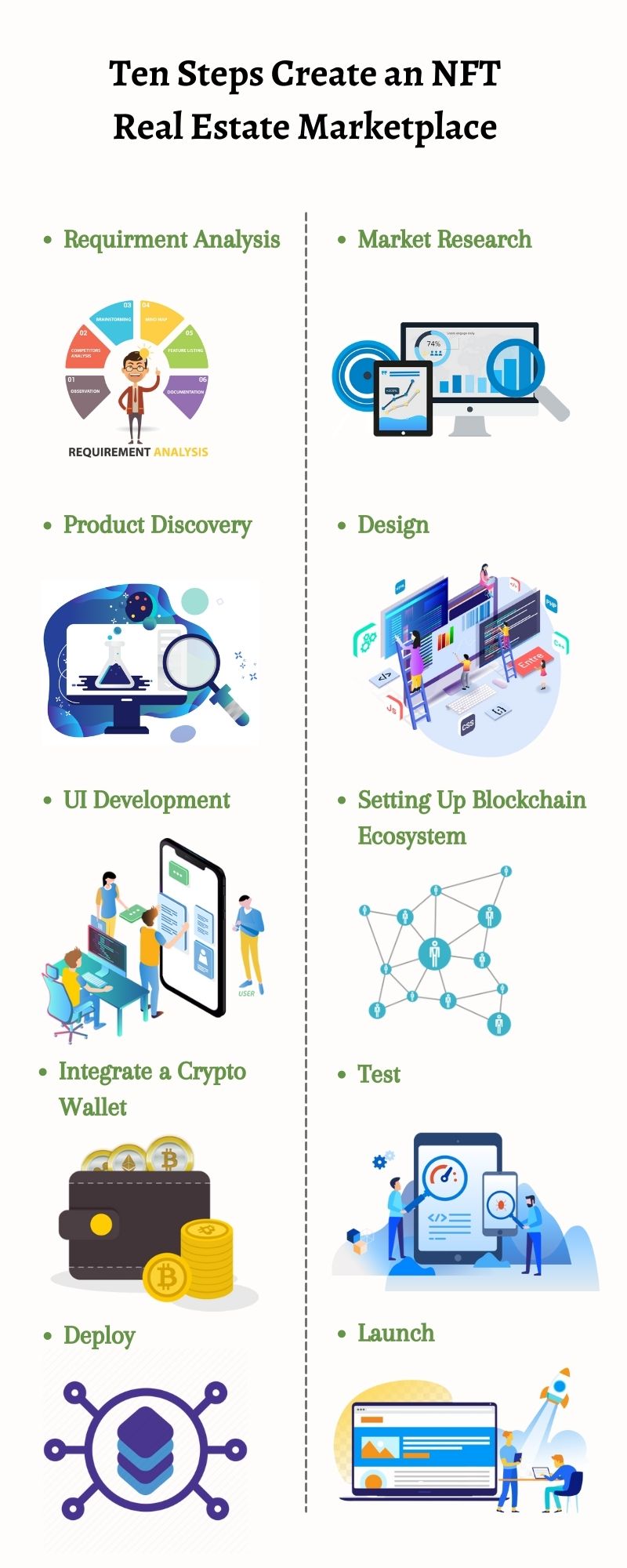Technologies like Blockchain, Virtual Reality, Augmented Reality, Decentraland, NFTs, and Cryptocurrency are transforming how users would interact with each other or avail services. Along with digital disruption, a surge in need for a more secure, connected, and transparent virtual space.
In recent years, NFT has become the new talk of the town. Users worldwide are using NFT marketplaces to list, sell, purchase, and manage real estate.
NFT in real estate has gained immense popularity.
As per statistics shared on Fool.com, 25% of NFT purchases in December 2021 were virtual lands worth more than $300 million.
Technologists worldwide are speculating possibilities for tendering interactive and wide virtual spaces using NFT marketplaces.
An NFT real estate market provides traders with a digital infrastructure to sell or purchase properties securely. These marketplaces can be niche-oriented or even combined, allowing the listing of NFTs of multiple niches.
Moreover, the NFT marketplace provides unique identification that restricts data tampering and counters against any security threats.
This blog post will explain the ten-step process of building an NFT real estate marketplace.
10-Step Roadmap to Create an NFT Marketplace

Requirement Analysis
Business owners seeking to create an NFT real estate marketplace must comprehend the fundamental requirements of the client. These requirements can be listed out from an investor, business partner, trader, NFT enthusiast, and a serious NFT real estate buyer’s perspective.
The more personalized your marketplace would, the more successful it can be. Among the primary requirements of an ideal NFT real estate marketplace is a smart listing and auction interface that can handle heavy traffic loads.
Market Research
NFT in real estate is a perfect combination of numerous technological opportunities. Blockchain technology is evolving and creating new technology trends in the market. It is now the responsibility of an NFT Marketplace development company to create solutions that aspire to continuous growth.
Competitor analysis, industry research, magazines, journals, and other informative resources can significantly benefit organizations offering NFT marketplace development services. Such analysis can assist you in creating highly personalized, scalable, and future-oriented NFT solutions.
Product Discovery
After you understand what you want to offer, it is time to analyze if your offerings are good enough for the market or your targeted audience. In the product discovery phase, you can scrutinize your NFT marketplace’s potential, primary features, and end objectives.
The product discovery stage also allows clients to visualize their product in real-time using advanced tools used for prototyping. The visualization of the product does not limit to the user interface but focuses on identifying the challenges, respective solutions, and possible performance in the market.
The process also outlines the complete project development and management plan, including critical components such as the structural foundation.
You can consider reading our comprehensive guide on NFT marketplace development to get a basic understanding of what NFT is and why do you need an NFT marketplace to do the job.
Design
Once you have a product structure available, you can carve an engaging marketplace design that would help your users interact with your product. To make your product user-ready for a versatile audience, you may need to adopt a multilateral product design strategy focusing on the diverse requirements.
A good design will convert your audience into potential customers fast effectively. A rich-featured NFT marketplace would comprehend the most complex demands compatibly in a saturated interface.
You would need a competent team of NFT marketplace designers that can utilize their understanding of the product design, NFT real estate marketplace, and your audience to ideate an appealing and result-oriented design.
UI Development
We have the design of an NFT real estate marketplace which can be translated into a fully-functional interface. NFT marketplace developers can code the features into the product using leading frameworks and programming languages to meet the end objectives.
NFT marketplace developers can use project documentation and design concept to realize the right-to-the-need product. Although the fundamental concept may remain the same, it is always best to hire UI developers who have a prior understanding of the NFT marketplace.
To create an NFT real estate marketplace, you may require a set of technology resources such as the following;
-
Cloud Hosting Platform
NFT real estate marketplaces require a flexible and scalable development environment to deploy the final product quickly.
Cloud hosting allows an NFT real estate marketplace development company to deploy the application on cloud networking rather than a single server.
Looking to Build your first NFT real estate marketplace? Discuss with us.
The cloud infrastructure benefits automated and controlled solutions and provide compatible APIs, web portals, and mobile applications.
-
Database Management System
A compatible DBMS allows you to create a smart, safe, and secure environment for handling a varying scope of data. The goal is never to hamper the credibility and sustainability of data on an NFT real estate marketplace.
Even if you consider the development of a cryptocurrency trading app, you can find the significance of DBMS in the technology stack.
-
Frontend and Backend Platforms
A Blockchain development company can use a range of frameworks, programming languages, and scripts to carve interactive frontend and strong backend that establish a client-oriented NFT marketplace. The primary technologies to create an NFT real estate marketplace include React.js, Express.js, and Node.js.
Setting Up Blockchain Ecosystem
NFTs are stored on a Blockchain. To ensure secure and smooth operation, implementing an ideal Blockchain is necessary. Smart Contracts allows the execution of protocols bound within an NFT marketplace. Developers use frameworks like Drizzle, Ganache, and Truffle to implement Blockchain applications.
Many NFT marketplaces are developed on Blockchain like Ethereum, Binance Smart Chain, Solana, Cardano, and Polygon. Developers would code a Smart Contract and deploy it into your NFT marketplace.
The goal of setting up a compatible Blockchain ecosystem is to;
- Ensure rich functionality.
- Keep track of the process.
- Streamline with futuristic Blockchain goals of the product.
Integrate a Crypto Wallet
A rich functionality crypto wallet is among the primary prerequisites of a multifeatured NFT real estate marketplace. It allows a smooth addition of crypto tokens and provides secure remittance of gas fees at both ends. To function secure and smooth transactions, you would need a crypto-compatible wallet that comprises features supporting the needs for a Blockchain-enabled NFT marketplace.
There are several crypto wallets available. You can also hire a cryptocurrency wallet app development company that would help you create a custom crypto wallet dedicatedly designed for your marketplace.
Test
Testing is more than finding bugs and errors. It is a phase where you consider the potential of your idea that has turned into a real product. It is time to analyze all minor and major chained within the application in the form of features, functionalities, interfaces, and even NFTs to be listed on the platform.
You analyze design, development, and other aspects that make it a complete NFT marketplace package.
Deploy
Once you have a deployable NFT marketplace product, you make sure to deploy it smoothly and securely on the server. A flexible deployment would ensure the integration of external resources and Smart Contracts into a single package. The feasible deployment leads to more prosperous business outcomes.
Launch
You can launch your NFT real estate marketplace on different channels post design and development. There can be several ways to showcase your product to a large audience, including potential customers, investors, and partners.
Conclusion
Real estate is among the most significant assets that can be converted into an NFT. The booming market of virtual lands is an evident example of its future predominance. Meta, formerly known as Facebook Inc., also bid its plans for their world of the virtual universe called Metaverse. Virtual spaces in Metaverse can depend significantly on NFTs, making NFT real estate technologically fruitful and a business-oriented domain.



